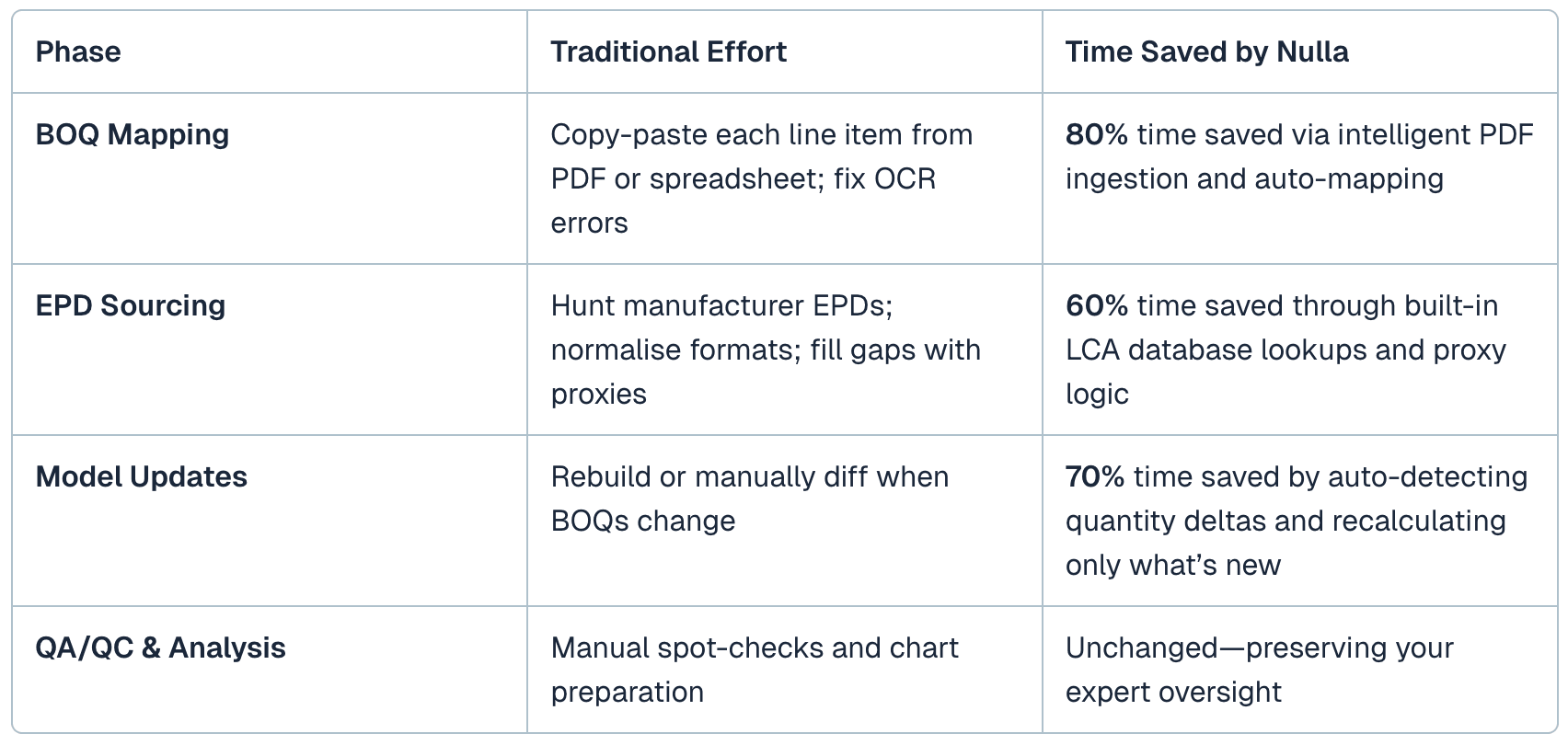In the world of embodied carbon assessment, data accuracy and turnaround speed are critical. Yet even the most seasoned sustainability or ESD consultants can find their schedule eroded by manual tasks—chief among them, mapping quantities to carbon factors and updating models as BOQs evolve. Nulla is built to address exactly these pain points, acting as a carbon assessment copilot that turbocharges your workflow without replacing your professional judgement.
The Challenge: Manual Data Burden
A typical embodied carbon assessment process breaks down into five core phases:
1. Manual BOQ Mapping (≈ 40% of time)
2. EPD Sourcing and Validation (≈ 25%)
3. Model Updates and Iterations (≈ 15%)
4. QA/QC Checks (≈ 10%)
5. Analysis & Reporting (≈ 10%)
Across hundreds of line items, changing design specs, and shifting data sources, consultants can spend days or even weeks simply entering and reconciling numbers before they reach the strategic, insight driving phase of their work. This bottleneck has undermined consultants' productivity and increased the cost of embodied carbon assessments, hindering the broader adoption of carbon planning in Australia’s building industry.
Nulla’s Solution: Automation Where It Matters
That’s exactly why we built Nulla—to free up your time for higher-value work and unlock your insights from the burden of manual data tasks. Supported by thinking model, Nulla automates and streamlines each of the top three time-sinks:

The result? Consultants reclaim up to 80% of their data entry hours, freeing them to focus on high-value analysis, stakeholder engagement, and low carbon design guidance.
Key Features That Make a Difference
1. Automated Quantity Extraction
Nulla accepts any common PDF format of BOQ.
Nulla’s OCR powered engine reads and structures every line item, automatically detecting quantities, units, and descriptions.
2. Smart Carbon Factor Matching
Nulla instantly aligns each material with the appropriate EPD or generic carbon factor, respecting the scope boundary of A1–A3.
It also flags missing data or outlier values so you can quickly spot where your judgement is needed.
3. Full Transparency in Assumptions & Calculation Logic
For every line item, Nulla documents the exact assumptions used, detailed calculation formulas, and any exclusion logic that applied.
Users can inspect, edit or override any mapping decision in seconds, ensuring your final model remains fully auditable and aligned with project-specific nuances.
4. Iterative Design Sync
Nulla can recognise and automatically send a “diff” report when a revised BOQ is uploaded.
It will reprocess changed items, and unchanged quantities will retain their previously matched factors.
5. Certification-Ready Outputs
Finally, Nulla will export audit-ready spreadsheets, linking each carbon factor back to its source EPD or proxy assumption.
Why Nulla Doesn’t Replace You–It Empowers You
Nulla is not an “AI black box” that spits out a number and disappears. Every mapping decision, every carbon factor, and every unit conversion will be fully transparent and editable. Consultants still make the final call. By handling the heavy lifting of data ingestion and baseline matching, Nulla elevates the ESD & Sustainability consultant’s productivity, shifting time investment from grunt manual work to valuable data analysis and dedicated client advisory.
Example: How Much Time Can You Save Using Nulla?
Consider a low-rise residential project BOQ with 200 line items. Traditionally, a consultant might need:
16 hours to map and validate BOQ quantities,
10 hours to hunt down and normalise 50 different EPDs,
6 hours per design revision to update and QA the model.
With Nulla, that effort reduces to:
~3 hours total for initial mapping and data-quality checks,
~2 hours for targeted EPD reviews (factored into your professional scope),
~2 hours per revision—because only changed items require recalculation and QA.
Overall, that’s a saving of 78%, or 25 billable hours—time you can reallocate to deepening carbon reduction strategy, coordinating stakeholder collaboration, or expanding your project pipeline.
Ready to reform your workflow? Try Nulla now and see how Nulla helps you unlock new efficiency and insight in your carbon assessment practice.





